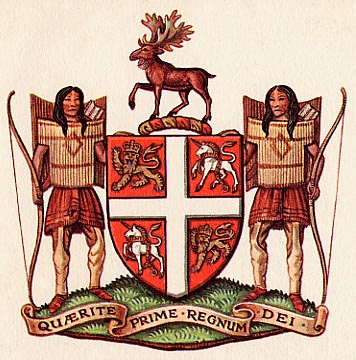
History

 |
Newfoundland History |
 |
[This text was written in 1949. For the full citation, see the end of the text. Parts in brackets [...], images and links have been added by Claude Bélanger.]
The influence of mercantilism was important in shaping the patterns of the early fisheries. Although the Portuguese, Spanish, and French were among the first to use the island as a base for fishing, they were gradually displaced by the more aggressive fishermen from the west of England who began visiting the island in force after 1550. Lack of solar salt forced the English to use the beaches along the coast to dry their catches before exporting them; this practice was the principal reason for the west country's opposition to settlement. With the defeat of the Spanish armada, the position of the west country interests was strengthened and pressure began to be exerted to obtain the support of parliament in preventing settlement. In these endeavours, the private interests of the west country fishermen coincided with those of mercantilistic England: exploitation of the fisheries was regarded by England as an ideal method of extracting new-world specie from Catholic Spain, as well as a method of training seamen. Thus the claims of the powerful west country group gained sympathy in parliament in the seventeenth century and found expression in a series of edicts designed to discourage settlement on the island as much as possible.
The English colonizers were forced to turn their attention to the mainland, particularly to New England, where settlement grew rapidly in the early seventeenth century. The productivity and aggressiveness of the New Englanders meant that patterns of trade began to emerge which had a significant influence on Newfoundland's development. New England found ready markets in the West Indies for her agricultural produce, in exchange for sugar and rum; Newfoundland came to be regarded as a good source of English bills of exchange and the New Englanders pressed for increased settlement of the island, in the hope of increased trade. Thus in the New Englanders, the west country interests met their first real opposition.
When, in the early 1860's, federation of the provinces of British North America became a definite prospect, Newfoundland showed considerable interest, and even sent two representatives to the Quebec conference in 1864. Ultimately, however, both economic and political factors conspired to keep her out of the federation. Unlike the provinces of British North America, Newfoundland had no heavy debt, no pressing railway problem, no immediate fear of United States hostility. Nor could she hold out much hope of broadening her markets through federation; indeed, in her only important export, codfish, she was in direct competition with Nova Scotia. Consequently, by 1869, the whole question was shelved and was not reopened until the mid-1890's.
The intervening period was one of general prosperity for the island, characterized by the further broadening of the bases of economic activity. Advances were made in farming and mining. A transinsular railway line was completed in a large semi-circle connecting St. John's with Port aux Basques in 1896. As was the case in Canada, construction was slow and uncertain and was only brought to completion by substantial government subsidies and land grants. The building of the railway generated considerable subsidiary activity, and numerous smaller types of enterprise sprang up, most of them locally managed and financed.
The disastrous
bank failure of 1895, however, put an end to the period of prosperity and
foreshadowed the chronic difficulties which have beset Newfoundland's economy
ever since. The immediate crisis was precipitated by the return of the bills
drawn on an English firm, one of whose members had died. A deeper reason,
however, lay in the inherent instability of Newfoundland's economy, stemming
from her too great dependence on the fishing industry. On December 10, 1894,
the Union and Commercial Banks, both local enterprises incorporated in 1854
and 1857 respectively, were forced to close their doors. Since the Union Bank
was the financial agent of the government, its failure was a serious blow
to the public credit. Unable to meet interest charges on the public debt,
the government turned first to Britain, then to Canada, for assistance. Britain,
however, would do nothing without first appointing a royal commission, and
this Newfoundland refused, largely through fear of losing her responsible
government. Negotiations with Canada, conducted at the Ottawa
conference of 1895, were equally unsuccessful, Newfoundland's renewed
interest in federation being thwarted by disagreements on financial grounds.
Failure of these efforts rendered the island's credit position even more precarious,
and only the forthright action of Robert
Bond, the colonial secretary, in raising loans on private money markets
in London saved the country from financial chaos. Two Canadian banks, the
Bank of Montreal and the Bank of Nova Scotia, opened branches in St. John's
in 1895, and established the Newfoundland currency on the basis of the Canadian
dollar.
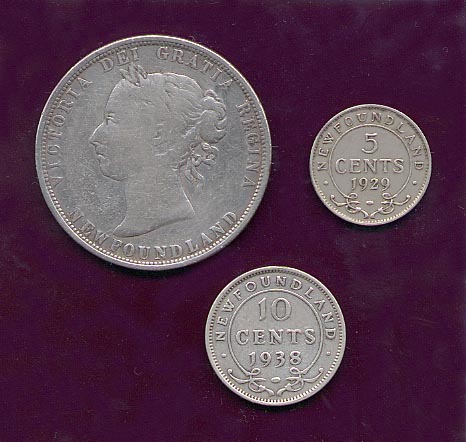
Examples of Newfoundland silver coins: the 50¢ was issued
in 1882,
the 5¢ was minted at the beginning of the Great Depression
and
the 10¢ in 1938. For a history of Newfoundland's banking
institutions and currency
consult this
page.
World
War I brought a period of prosperity to Newfoundland, mainly because of
the prosperous condition of the fishing industry. Prices were high and the
demand was steady. Over-optimism and over-expansion characterized economic
activity, however, and the cultivation of land fell off. The result was an
inflationary period immediately following the war, followed by a depression
in the early twenties. The chronically unprofitable railway had to be taken
over by the government in 1923, along with steamship and telegraph services.
The rise of economic nationalism in many European countries brought renewed
hardships to the fishing industry and emphasized once again the necessity
of greater diversification in the country's economy. Increased competition
was encountered from Norway, Iceland, Spain and Italy. Iron
ore mining on Bell island, begun in 1895, slackened during this period
in response to a decline in the Nova Scotia steel industry.
The twenties saw new efforts at diversification. An
extensive highway program was undertaken in 1924; the Corner
Brook paper mill was completed in 1925; the output of mines, forests,
and agriculture were generally increased. But such efforts were now pursued
only at the cost of heavy capital imports and foreign borrowing. Government
provision of public utilities to support industrial diversification, combined
with her railway deficits and the costs of post-war demobilization, doubled
the public debt between 1920 and 1930. Although diversification had lessened
the country's dependence on the fishing industry, she remained as dependent
as ever on foreign markets, and demand for her products was still extremely
sensitive to world economic conditions. In general, servicing of the debt
during this period had to be financed by further borrowing abroad.
The depression
of 1929 struck Newfoundland with cruel
severity. A sudden shrinkage of exports, combined with increasing demands
on the public treasury, brought the country to the brink
of ruin. Wages fell drastically; unemployment was increased by the disappearance
of opportunities for seasonal employment outside the country, and relief expenditures
rose to unprecedented heights. Deficits, piled up until in 1933 the national
debt was over $100 millions, 95 per cent of it held outside the country, particularly
in the United Kingdom. Finally, in 1933, a royal
commission was appointed at Newfoundland's request, to report
on the situation. As a result of this investigation, Newfoundland relinquished
responsible government and placed itself under a commission
government in 1934.
World
War II did much to improve Newfoundland's credit position. American and
Canadian defence expenditures were an important factor in reducing the total
debt from $101 millions in 1931 to $88 millions in 1945. In addition, the
average interest rate had fallen from 5 to 3 per cent. But these favorable
factors should not obscure the fact that Newfoundland's peacetime debt position
since 1920 has been one of persistent deficit and the future holds no definite
prospect that the situation will be changed. The inexorable facts of meager
natural resources, low productivity and consequent low taxable capacity, have
still to be taken into account in any attempt to estimate future government
debt.
The progress of diversification of industry brought
the pulp-and-paper industry into position as the foremost contributor to national
income in the late thirties, although the fishing industry still provides
livelihood for the largest number of people. Mining holds third place in producing
national income. Agriculture and manufacturing are still geared to the local
markets. Exports are still the basis of the country's livelihood, and a stable,
multi-lateral world trading system is thus of prime importance.
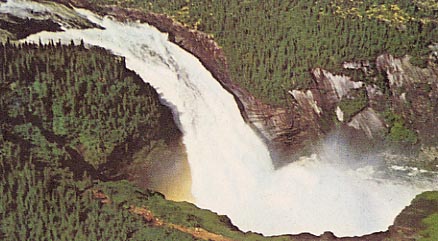
Since this text was written in 1949, it does not discuss
a great resource of Newfoundland that is drawn
from the Labrador
region: hydro-electricity.
Picture above is Churchill
Falls.
Over a 32 km distance, the river level falls more than 300m
with a drop
of over 75m at the falls themselves. In the 1970's, the river
was
harnessed and since 1974 it has been producing vast amounts
of power that is
directed toward Montreal and the United States. Churchill
Falls has a generating capacity
of over 5,225,00 kw, one of the largest in the world. The
contract signed with Hydro-Québec
has been the subject of much debate between Newfoundland and
Quebec. This
debate is an extension of the Quebec-Labrador
boundary dispute.
[See the Churchill
Falls Corporation Limited (Lease) Act, 1961,
Hydro-Québec
v. Churchill Falls, 1988, and the speech
of Brian Tobin,
Premier of Newfoundland, explaining the position of his province
in 1996]
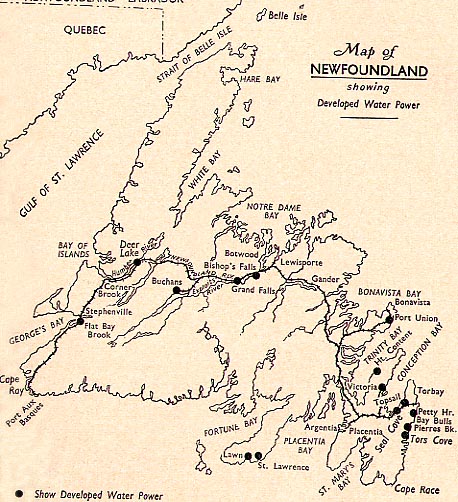
Newfoundland map of the early 1950's showing the
hydro-power plant developments.
For recent statistics, see the Census of Newfoundland,
1945, and numbers of Foreign Trade, published by the Canadian department
of trade and commerce. For an extensive bibliography of the subject, see the
appendix to R. A. MacKay (ed.), Newfoundland: economic, diplomatic, and
strategic studies (Toronto, 1946).
Owing to the structure and climate of the island, fertile
soils are rare in Newfoundland. The glacial till which covers the island is
poor in plant food, while the bleak climate results in soils marked by an
absence of bacteria and worms which are necessary to break down such humus
as may be present. Only by a lengthy process of manuring can the soils be
improved; hence there are no extensive croplands, but only small patches.
There are said to be only 4,000 farmers (2,809 in 1945 out of a total population
of 322,000), and they cultivate less than half of one per cent of the total
area. However, almost every fisherman has a small garden, where potatoes and
other vegetables are grown, and so about 40,000 people help to produce the
food of the population.
The chief farms, naturally, are close to the larger
centres of population. Thus there are many farms on the Avalon
peninsula, near St.
John's, and small areas of a few acres each are to be found near Bishop's
Falls and Grand
Falls. In the far south-west corner, along the Codroy valley, is the largest
area devoted to farms. Here soils and summer temperatures are more favourable
than in most parts of the island. Hay, potatoes, oats, and buckwheat are the
chief crops. Much of the hay is sold as feed for horses that are used in the
woods by logging companies. Some produce is sold and much more could be sold
profitably to the settlement of Port
aux Basques nearby, since it, as all other large settlements, has to import
almost all foodstuffs except potatoes and codfish. At some farms along Deer
lake, maize and pumpkins usually ripen, but such crops are exceptional.
To the north-west near Deer lake are many clearings in the forest, made after
soil surveys by the government, and here it is hoped that farmers will settle
and grow crops while earning wages through part of the year by cutting timber
for the paper mills.
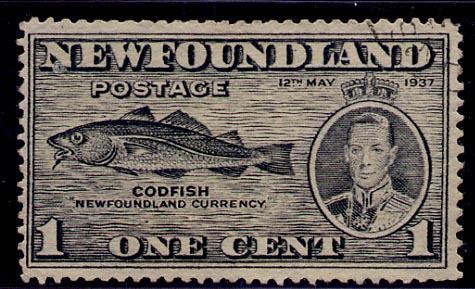
The cod fisheries have played a dominant rôle in the economic, political, and social history of' Newfoundland. The island is located in the northern part of a vast area, extending from New England to Labrador, in which cod is to be found in large numbers. Sharply affected by seasonal changes, it very early became the centre of a summer fishery in which the relatively smaller sizes of cod were taken and dried with solar heat and smaller quantities of solar salt.
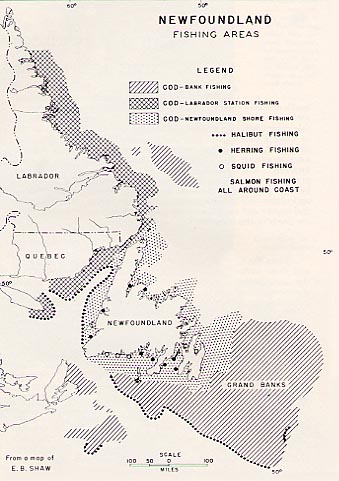
Map outlining the principal species and the main areas
where
Newfoundland fisheries were carried out until the
establishment of the moratorium
of 1992.
[Consult the issue of the Canadian
Geographic Magazine on this subject]
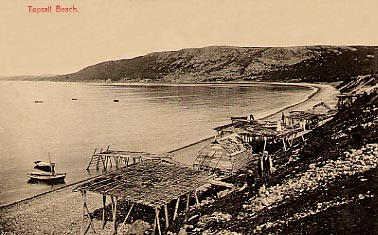 Prosecuting the fishery in Newfoundland and returning
to the west country with dried fish for export to Europe was gradually displaced
by the practice of carrying fish directly from Newfoundland to European markets,
especially in the. Mediterranean area. Fishing ships proceeding to Newfoundland
early in the spring, carrying on the fishery during the summer months and
taking the product to European markets, were faced with the problem of transporting
large numbers of men to Newfoundland for the fishery, then to the European
markets and back to the west country. Colonizers, represented by the London
and Bristol Company (1610), proposed to establish a settlement which would
enable men to stay over the winter, to carry on a resident fishery, and to
provide cargoes for sack ships for the Mediterranean markets. This proposal
and others similar to it were ruthlessly defeated by west country fishermen
who insisted on the rights of a free fishery which gave the first arrival
each year the position of admiral for the season. The difficulties of developing
agriculture, to supply food for winter settlements, further restricted the
growth of settlement in Newfoundland and favoured the migration of population
to New England.
Prosecuting the fishery in Newfoundland and returning
to the west country with dried fish for export to Europe was gradually displaced
by the practice of carrying fish directly from Newfoundland to European markets,
especially in the. Mediterranean area. Fishing ships proceeding to Newfoundland
early in the spring, carrying on the fishery during the summer months and
taking the product to European markets, were faced with the problem of transporting
large numbers of men to Newfoundland for the fishery, then to the European
markets and back to the west country. Colonizers, represented by the London
and Bristol Company (1610), proposed to establish a settlement which would
enable men to stay over the winter, to carry on a resident fishery, and to
provide cargoes for sack ships for the Mediterranean markets. This proposal
and others similar to it were ruthlessly defeated by west country fishermen
who insisted on the rights of a free fishery which gave the first arrival
each year the position of admiral for the season. The difficulties of developing
agriculture, to supply food for winter settlements, further restricted the
growth of settlement in Newfoundland and favoured the migration of population
to New England.
The rise of New England and its demand for European
goods led to the growth of trade with Newfoundland. As a result of this increase
in trade, settlement began to expand in spite of continued and more vigorous
efforts of the west country to check it. Partly as a result of restrictions
on settlement imposed at the instigation of the west country, men known as
byeboatmen
began to dominate the industry. They were brought on the fishing ships as
passengers each spring, operated a fishery in Newfoundland independently of
the fishing ships, and sold their product before their return to England in
the autumn. The fishing ships were in a sense compelled to serve as sack ships
carrying passengers to Newfoundland and the finished product to European markets.
Following the treaty
of Utrecht, in 1713, New England became even more important as a base
of supplies for Newfoundland and as a support to growth of settlement. Fishermen
were attracted to New England and to the more profitable operations carried
on by byeboatmen, and fishing ships were compelled to rely on resident fishermen,
particularly on Irish labor which filled the gap created by emigration. The
growth of settlement was accompanied by extension to the south to occupy territory
centering about Placentia,
which had been vacated by the French after 1713, and by the development of
the bank fishery. St. John's became the centre of a resident fishery; fishing
ships became to an increasing extent sack ships, or retreated, on the development
of new areas, beyond the effects of competition from St. John's.
After the treaty
of Paris, Labrador was annexed to Newfoundland. In 1765 regulations favoured
the development of its fisheries by fishing ships, but in the Quebec
Act of 1774 Labrador was returned to Canada, and attempts were made to
re-establish the system of grants existing before the introduction of a free
fishery. Expansion to the north was accompanied by the development of the
fur trade and of the salmon fishery. The outbreak of the American revolution
cut off supplies of goods from New England. Palliser's
Act in 1775, and other legislation, attempted to offset the effects by
establishing a system of bounties which improved the position of fishing ships
and restricted the resident fishery. [See the British
Report on Newfoundland fisheries in 1776.]
In the treaty of Versailles the French abandoned fishing
rights from Cape
Bonavista to Cape St. John in return for rights along the coast from Point
Riche to Cape Ray. They remained in possession of St.
Pierre and Miquelon. During the long period of wars ending in 1815, Newfoundland
became increasingly a centre of settlement, and the fishing ships practically
disappeared. Territory north of Cape Bonavista was rapidly occupied. The seal
fishery emerged and expanded rapidly. Until New England and France were able
to revive their fishing industries, Newfoundland had an important market advantage
which was evident in higher prices. The Maritime provinces replaced New England
as a base of supplies, and the migration of labor to New England was checked.
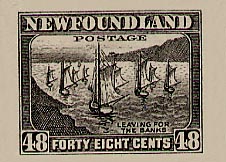 The increasing importance of settlement created demands
for the extension of political institutions. In 1832 provision was made for
representative
government, and emergence of responsible
government in 1854 was accompanied by the development of resistance to
French interests in Newfoundland. In an attempt to re-establish the fisheries,
France introduced a system of substantial bounties which accelerated the use
of the trawl system of fishing, in which a line to which was attached a large
number of hooks was set out and visited at frequent intervals. The system
required large quantities of bait, which was purchased to an important extent
by fishermen in St. Pierre and Miquelon from settlements on the south shore
of Newfoundland, and attempts were made in Newfoundland to check competition
from the French fishery by imposing restrictions on exports of bait. An agreement
between France and Great Britain in 1857, designed to settle the difficulties
arising from conflicts between French and English fishermen, was followed
by protests from Newfoundland and recognition of the fact "that the consent
of the community of Newfoundland is regarded by Her Majesty's government as
the essential preliminary to any modification of their territorial and maritime
rights". Recognition of Newfoundland's control over natural resources was
followed by various measures designed to restrict the French fishery and to
extend Newfoundland's territorial rights. In 1881 Great Britain conceded territorial
jurisdiction over the "French
shore" to the Newfoundland government. Newfoundland refused to ratify
an agreement between France and Great Britain in 1885 and passed bait legislation
in 1887. France and Great Britain established in 1889 a modus vivendi which
was renewed from year to year and was the object of continued protests from
Newfoundland. The controversy became more acute with the growth of a lobster
fishery and was finally ended by the purchase of French rights by Great Britain
in 1904.
The increasing importance of settlement created demands
for the extension of political institutions. In 1832 provision was made for
representative
government, and emergence of responsible
government in 1854 was accompanied by the development of resistance to
French interests in Newfoundland. In an attempt to re-establish the fisheries,
France introduced a system of substantial bounties which accelerated the use
of the trawl system of fishing, in which a line to which was attached a large
number of hooks was set out and visited at frequent intervals. The system
required large quantities of bait, which was purchased to an important extent
by fishermen in St. Pierre and Miquelon from settlements on the south shore
of Newfoundland, and attempts were made in Newfoundland to check competition
from the French fishery by imposing restrictions on exports of bait. An agreement
between France and Great Britain in 1857, designed to settle the difficulties
arising from conflicts between French and English fishermen, was followed
by protests from Newfoundland and recognition of the fact "that the consent
of the community of Newfoundland is regarded by Her Majesty's government as
the essential preliminary to any modification of their territorial and maritime
rights". Recognition of Newfoundland's control over natural resources was
followed by various measures designed to restrict the French fishery and to
extend Newfoundland's territorial rights. In 1881 Great Britain conceded territorial
jurisdiction over the "French
shore" to the Newfoundland government. Newfoundland refused to ratify
an agreement between France and Great Britain in 1885 and passed bait legislation
in 1887. France and Great Britain established in 1889 a modus vivendi which
was renewed from year to year and was the object of continued protests from
Newfoundland. The controversy became more acute with the growth of a lobster
fishery and was finally ended by the purchase of French rights by Great Britain
in 1904.
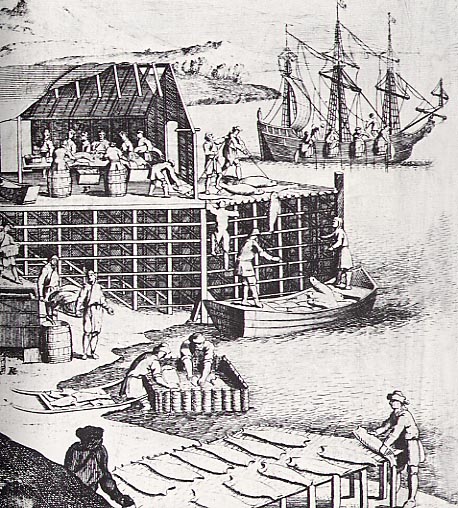
Detail from Eric Mill's map of North America published 1712-1714.
According to its author, it shows a view of a stage and the
manner of fishing for curing
and drying cod on the island of Newfoundland. The popular
scene contains
several inaccuracies: the type of ship used for fishing, the
fact that cod
and seals are harvested at the same time, the fish stage itself,
etc.
With responsible government Newfoundland pressed for
exclusion not only of France but also of the United States, Canada, and Great
Britain, from the fishery. Following the reciprocity
treaty (1855-1866) with the United States, Newfoundland introduced and
enforced regulations which rapidly brought to an end participation
of the United States in the Labrador fishery. During the period of the
treaty of Washington (1873-85),
Newfoundland became increasingly aggressive against American infringements
and after its termination Newfoundland attempted to negotiate the Blaine-Bond
convention with the United States, but was defeated by Canadian intervention.
A second attempt to secure reciprocal arrangements in the Hay-Bond treaty
was defeated by the American senate and was followed by renewed attacks on
participation of Americans in the Newfoundland fishery. Disallowance of legislation
against the United States by Great Britain was followed by protests from Newfoundland
and submission of the whole problem to the Hague tribunal, which reported
in favour of the position of Newfoundland. Finally, an attempt on the part
of Canada to secure a broad interpretation of rights on the Labrador was defeated
in a privy
council decision of 1927.
Exclusion of fishermen from foreign countries from Newfoundland
facilitated expansion of the local fisheries to the west coast and on the
Labrador. The high prices of cod during World War I were followed by a decline
and by increasing competition in European markets from cod produced more cheaply
by steam trawlers in Iceland and elsewhere; hence Newfoundland trade shifted
to West Indian and South American markets. Problems of centralized marketing
in purchasing countries were met by the establishment of marketing boards.
Recent developments have been the extension of marketing organizations, encouragement
of the fresh fish industries, exploitation of types of fish other than cod,
and establishment of a research centre. The number of people engaged in the
fishery decreased, between 1921 and 1945, from 65,000 to 32,000. [For a discussion
of the recent developments in Newfoundland fisheries, consult this
web site. Much material can be found in this bibliography.]
For a recent bibliography of the subject, see the appendix to R. A. MacKay (ed.), Newfoundland economic, diplomatic, and strategic studies (Toronto, 1946).
About 16,000 square miles, or approximately two-fifths of the area of Newfoundland is forested, mainly along the river valleys. Labrador has extensive forest areas along the coasts, but there has been no comprehensive inventory, and utilization is restricted to the requirements of the sparse population. In Newfoundland too, lumbering was at first on a small scale to supply local needs, and sawing was done by numerous small mills scattered along the coast.
There were
also, for some years, larger mills which exported lumber. The French Company
of Quebec, operating mills at Botwood
(1890-1900), was succeeded by the Exploits
River Company (1900-1906), which was absorbed by the Newfoundland Pine
and Pulp Company. The Lewis Miller Company of Scotland (1900-1903), with mills
at Millertown and Glenwood, was sold to the Newfoundland Timber Estates Company,
which shipped dimension stock from Lewisporte
to Argentina, and in 1905 was resold to Anglo-Newfoundland Development Company.
Central Forest Limited, which held limits on Rattling brook, Notre
Dame bay, and Norris arm, and mills at Norris arm, was sold to the A.
E. Reed Company which operated from Bishop's
Falls.
Most of the extensive, though scattered, stands of white
pine, upon which the lumbering industry was based, have been removed. The
present forests consist of white birch, which has value as fuel, and of pulpwood
species, so that lumbering has been replaced by the pulpwood industry.
Mining in Newfoundland
[For an extensive discussion of Pre-Confederation mines
in Newfoundland, consult Wendy Martin's Once
upon a Mine. The Story of Pre-Confederation Mines on the Island of Newfoundland.]
Since much of the island of Newfoundland consists of very ancient rocks, a
rich supply of metals is to be expected. Unfortunately only two large fields
are in operation at present, the Buchans
copper mine; and the Wabana iron mine on Bell
island. Between 1888 and 1912 large amounts of copper were obtained at
Tilt Cove, but these mines are now unimportant: Discovery of the rather complex
lead-zinc-copper ores at Buchans in the Exploits valley was made as early
as 1905, but it was not until 1928 that the flotation process enabled these
ores to be treated satisfactorily.
The most interesting, mine is Wabana, situated on Bell
island in Conception bay, only 20 miles north-west of St.. John's. There ere
are three beds of hematite iron ore which dip at 'a shallow angle under the
sea to the north, and many of the workings are under the sea. The first cargo
of iron ore left Bell island in 1895 to be smelted with the coal of Pictou,
Nova Scotia. In 1899 the Dominion Steel Company purchased the mines, and the
ore is now carried to Sydney, Nova Scotia, and smelted at the large steel
works in the north-east of that city. There are said to be from 2.5 to 10
thousand million tons of ore available. In 1947 the mine produced 1,280 thousand
tons of iron ore.
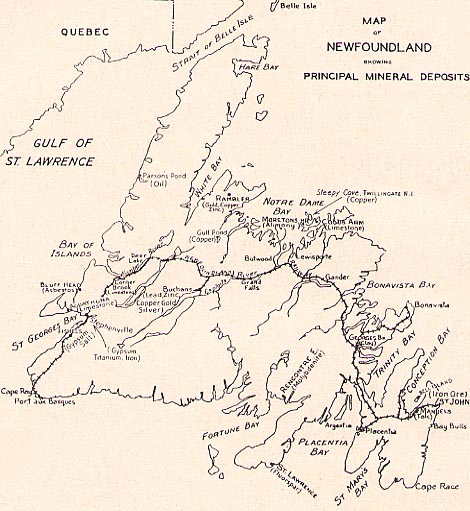
Newfoundland map of the early 1950's showing the mineral
wealth of the island
Coal, though not abundant, occurs in folded rocks in
the western depression near. Deer lake and the Codroy, but very little mining
has been done. Fluorspar is found on a commercial scale on Burin
peninsula. Manganese is reported from Avalon (near Trepassey), and molybdenum
in places on the south coast. There are oil shales near Deer lake which may
be used to produce oil when extraction becomes economically feasible. Marble
is found on the east coast of the Long Range peninsula, but is not regularly
quarried.. Iron ore was discovered in Labrador in 1895, and large deposits
of high-grade ore have been mapped along the upper Kaniapiskau river, but
development awaits construction of a railroad by which ore could be, shipped
south to the St. Lawrence river.
Bibliography:J.
B. Jukes, Excursions in and about Newfoundland (London, 1842),; A.
Murray, Report on the geology of Newfoundland (Montreal, 1866); J.
P. Howley, Coal deposits of Newfoundland (St. John's, 1918) ; C. Schuchert,
Stratigraphy of western Newfoundland (Washington, 1934) ; A. K. Snelgrove,
Mines and mineral resources of Newfoundland (St. John's, 1938) ; G.
Taylor, Newfoundland, a study of settlement (Toronto, 1946).
The forests of Newfoundland now consist principally
of pulpwood species: balsam fir, white and black spruce, and some second growth
larch. Consequently the lumbering industry, which used white pine, has given
way to a pulp-and-paper industry whose exports, in 1948, amounted to $ 40,000,000,
or about half of all exports.
Production first began when the Newfoundland Wood Pulp
Company, incorporated in 1897, built a sulphite mill with a daily capacity
of 20 tons at Black River, Placentia bay. The mill, after operating for five
or six years, was discontinued because of a shortage of water power, but had
provided valuable information on possibilities of the industry on the island.
Other ventures followed, and production is now [1949] in the hands of two
large companies, the Anglo-Newfoundland Development Company and Bowater's
Newfoundland Pulp and Paper Mills.
Bowater's holds limits amounting to 11,000 square miles,
mostly along the north-west coast and in the Codroy, Humber, and Gander basins.
The mill, erected at Corner
Brook in 1923 by the Newfoundland Power and Paper Company and bought by
Bowater's in 1936, has at present a daily capacity of 1,000 tons. The power
house is at Deer lake. Shipping is done from Corner Brook and, in the winter,
from Port aux Basques.
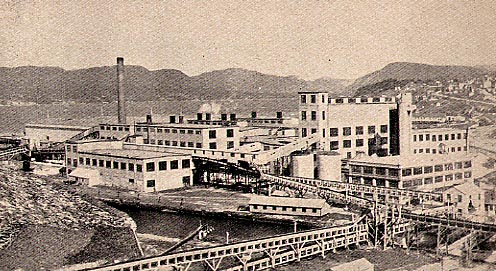
View of the Bowaters pulp and paper mill of Corner Brook
(early 1950's)
The Anglo-Newfoundland Development Company, incorporated
in 1905, holds limits in the Exploits
valley, the Terra
Nova basin, and along the west shore of White bay, about 7,500 square
miles in all. Power is generated at a dam across the Exploits river. A mill
at Grand
Falls, with daily capacity of 120 tons, was completed in 1909, and the
present capacity is 600 tons. A groundwood mill, which was operated by A.
E. Reed Ltd. at Bishop's
Falls between 1909 and 1928, is now owned by Anglo-Newfoundland, and the
ground-wood is pumped to the Grand Falls mill. The mills are connected by
railway to the port of Botwood.
The two large companies provide seasonal employment
in the woods for some 5,000 men, and steady employment for more than 3,000
in the mills.
Bibliography.See Forest resources and industries, a memorandum prepared for the British Empire Forestry Convention (London, 1920); J. Turner,. Forests of Newfoundland in J. R. Smallwood (ed.), Book of Newfoundland (St. John's, 1937); R. A. MacKay (ed.), Newfoundland: economic, diplomatic, and strategic studies (Toronto, 1946) ; G. Taylor, Newfoundland (Toronto, 1946).
Construction of the first railroad in Newfoundland began
in 1881, when the Newfoundland Railway Company undertook to build a narrow
gauge line from St. John's to Harbour Grace. There was considerable opposition
to the railway, and in the summer of 1881 several hundred inhabitants of the
south shore of Conception bay, persuaded by agitators that their possessions
were being taken away from them, armed themselves, and in a riot which has
become known as the "battle of Foxtrap", put a temporary stop to construction
of the line. After completing some 60 miles of track, the company defaulted,
and the line reverted to English shareholders who completed the line to Harbour
Grace. Daily service, six days a week, from St. John's to Salmon Cove, was
begun in 1884.
The Whiteway
administration, which had inaugurated the railway policy, was replaced
in 1885 by the Thorburn
government, which built and in 1888 opened a railway from Whitbourne to
Placentia. Construction was managed by the government, and had been carried
forward to Rantem in 1889 when it was decided by Sir William Whiteway, who
had returned to the premiership to have the line completed by a contractor.
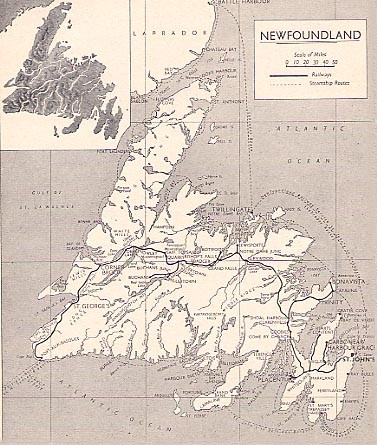
Map of the railway and ferry lines of Newfoundland
in the early 1950's
The contract was awarded to Robert
Reid in 1890, and the road had been completed, through Norris Arm to Port
aux Basques, by 1897. Under an agreement signed in 1893, Mr. Reid undertook,
for a grant of 5,000 acres for each mile of track, to operate the railroad
for ten years; and the first train to cross the island left St. John's on
June 29, 1898.
By another contract, the "Reid deal" concluded by the
ministry of Sir
James Winter in 1898, the Reid Newfoundland Company was given further
grants of land and gained control not only of the railway but also of the
St. John's dry dock, the telegraph lines, and the coastal mail and passenger
service.
 This Reid contract was modified by a new agreement with
the government of Sir
Robert Bond in 1901, but the company continued to operate the railway
and steamship services. In 1910 the company contracted with the government
of Sir
Edward Morris to build six branch lines, and four of the lines were in
operation by 1915. In 1920 the Reid Newfoundland Company, then operating at
an annual loss of about $1,500,000, appealed to the government for financial
aid. In 1921, operation of the railway and steamship services was taken aver
temporarily by a government commission, and Sir George Burry, a former vice-president
of the Canadian Pacific Railway, was called in to make recommendations. Acting
upon his advice, the government appointed a general manager of the railway
to act under the supervision of the Reid Newfoundland Company, but the arrangement
led to a deadlock and finally, on July 1, 1923, for a consideration of $2,000,000,
the company and its subsidiary companies retired absolutely from all transportation
operations in Newfoundland.
This Reid contract was modified by a new agreement with
the government of Sir
Robert Bond in 1901, but the company continued to operate the railway
and steamship services. In 1910 the company contracted with the government
of Sir
Edward Morris to build six branch lines, and four of the lines were in
operation by 1915. In 1920 the Reid Newfoundland Company, then operating at
an annual loss of about $1,500,000, appealed to the government for financial
aid. In 1921, operation of the railway and steamship services was taken aver
temporarily by a government commission, and Sir George Burry, a former vice-president
of the Canadian Pacific Railway, was called in to make recommendations. Acting
upon his advice, the government appointed a general manager of the railway
to act under the supervision of the Reid Newfoundland Company, but the arrangement
led to a deadlock and finally, on July 1, 1923, for a consideration of $2,000,000,
the company and its subsidiary companies retired absolutely from all transportation
operations in Newfoundland.
The government improved the main line, and built a new
dock. The 1930's saw several of the branch lines abandoned. The construction
of large military bases on the island during World War II brought about heavy
increases in freight and passenger traffic, so that the railroad's revenue
tripled and, for almost the first time, met the cost of operation.
The Newfoundland Railway and Steamship Services in 1949
became known as Canadian National Railways, Newfoundland Services.
Roads.
Since the sea has served and still serves as highway
between settlements on the coast of Newfoundland, development of roads has
not been rapid. However, there are a number of highways, mainly gravel-surfaced,
in some districts, and new construction is under way.
On the west coast a gravel road loops around the head
of St.
George's bay from Flat Bay to Lourdes, and farther north, roads out of
Corner Brook run south to St. George's lake and north to Bonne bay. On the
north-east coast, a road loops from Leamington through Botwood, Grand Falls,
and Badger, and swings north to Hall's bay. On the south coast, there is a
road around the foot of the Burin peninsula. Another road, across the top
of the peninsula, from Terrenceville to Goobies, joins the new Cabot highway
which crosses the Rantem isthmus and links Bonavista with St. John's.
The most highly developed system of roads, of course,
is to be found on the Avalon peninsula. A coastal highway runs from Trepassey,
in the south, through St. John's and around to New Harbour, in the north-west.
There are, in addition, other highways and branches, so that most of the settlements
on the peninsula may be reached by road. The roads from St. John's to Portugal
Cove and St. John's to Carbonear
have been paved, and some paving has been done on the highway leading southward
from St. John's.
Sealing, once an important industry in Newfoundland,
is now mainly of historic interest.
The hunt takes place, between March 14 and May 1, off
the northern shores, during the northern migration of the hood and harp seals.
The principal objects of the hunt are the young seals, which are valuable
for their fat.
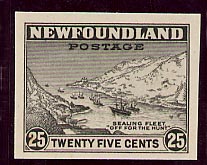 In the early days, winter residents caught seals with
nets along the shores. Later, small boats were used in the hunt, and later
still, sailing vessels. There are records of seal oil being exported as early
as 1749. Between 1830 and 1860 the average annual catch was close to 440,000
seals, and in the spring of 1855 there were 400 vessels and 13,000 men engaged
in the hunt. Steamships were first used in the hunt in 1863, and by 1880 had
replaced the sailing vessels. In 1906 there were twenty-five steamers, in
1936 only eight, and in 1945 only two went to the ice for seals.
In the early days, winter residents caught seals with
nets along the shores. Later, small boats were used in the hunt, and later
still, sailing vessels. There are records of seal oil being exported as early
as 1749. Between 1830 and 1860 the average annual catch was close to 440,000
seals, and in the spring of 1855 there were 400 vessels and 13,000 men engaged
in the hunt. Steamships were first used in the hunt in 1863, and by 1880 had
replaced the sailing vessels. In 1906 there were twenty-five steamers, in
1936 only eight, and in 1945 only two went to the ice for seals.
The decrease, apparently, is due to increasing costs
and decreasing demand.
The seal-hunt, coming as it does in early spring, provides
off-season employment for fishermen. Since sealing crews receive part of the
catch, competition for a berth on a sealing vessel has been keen, and until
the sealers' strike of 1902, crew members paid berth-money.
Since the hunt must take place among the ice-floes,
and since there is never any certainty of finding seals, the industry has
been a dangerous one for both crews and owners, and there have been many wrecks
and other disasters.
Bibliography.The authoritative record of the Newfoundland seal fishery is Chafe's sealing book, a collection of annual reports made by L. G. Chafe (third edition edited by H M. Mosdell, St. John's, 1923). Other useful works are C. Michael, The seal and herring fisheries of Newfoundland (Montreal, 1873); A. Kean, Old and young ahead (London, 1935); W. H. Greene, The wooden walls among the ice floes (London, 1933); R. A. Bartlett, Sealing saga of Newfoundland (National Geographic, July 1929); J. T. Callanan, The Newfoundland seal hunt in J. R. Smallwood (ed.), Book Newfoundland (St. John's, 1937), Meaney, Saga of sealing (Atlantic Guardian, 1945); J B. Jukes, Excursions in and about Newfoundland (London, 1842).
Shipbuilding has been carried on as a local industry
in Newfoundland for many years, mainly to supply vessels needed in the fisheries,
and since about 1920 there have been several larger vessels built for the
Atlantic trade. In 1942 the Newfoundland government established at Clarenville
a shipyard which built, first of all, ten wooden freighters of 300 tons. In
1947-48 the Clarenville yards, together with other shipyards on the island,
produced 56 vessels with a total tonnage of 2,663.
Telegraphs and Telephones.
Newfoundland figured largely in the early development
of transatlantic telegraphic service, and is the western terminus of several
submarine lines.
Telegraphic service between points on the island is
conducted by the government under the post-office department. In 1946, out
of 617 post-offices in Newfoundland and Labrador, 171 were telegraph offices.
Of these, 67 were land-line offices, 95 were wireless offices, and 9 were
both. On the Labrador coast, and in some other outlying areas, service is
by radio-telegraph.
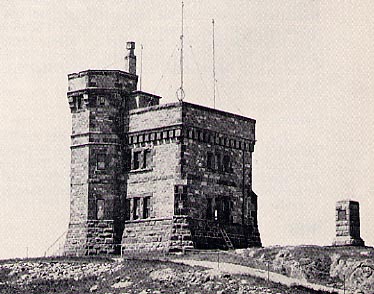
It was from Cabot Tower, situated on top of Signal
Hill and overlooking the city
and port of St.
Johns, that Marconi
received from Cornwall, England, the first transatlantic wireless
message on December 12, 1901.
Telephone service, operated by the Avalon Telephone
Company, reaches most parts of the island ether by land-lines or by radio-telephone,
and forms a link between some of the smaller settlements and the postal telegraph
stations.
Though Newfoundland is often thought of as a one-industry
country, and though the fisheries do occupy a large proportion of the population, fisheryproducts
at present account for only about one-third of the island's exports.
Exports in 1947-48 amounted to $77,839,000, an all-time
record and more than double the amount for 1938. For the ten-year period,
exports and imports may be tabulated thus, in thousands of dollars

Exports Imports
1938 ............ 34,483 27,912
1940............. 32,827 28,422
1942............. 37,416 64,539
1944............. 42,397 62,485
1946............. 61,012 65,895
1948............. 77,839 105,059
Exports in 1947-48 were to the United States,
United Kingdom, Canada, and other countries, in this ratio? 26 to 13.5 to
9.5 to 28.5 ? and consisted of the following commodities:
salt codfish ... 20.9 per cent
other fishery products . . . . .15.1
minerals... 19.6
newsprint and newspaper.. 32.0
other forest products . .... . 6.9
other products ... 2.2
re-exports. ...
3.3
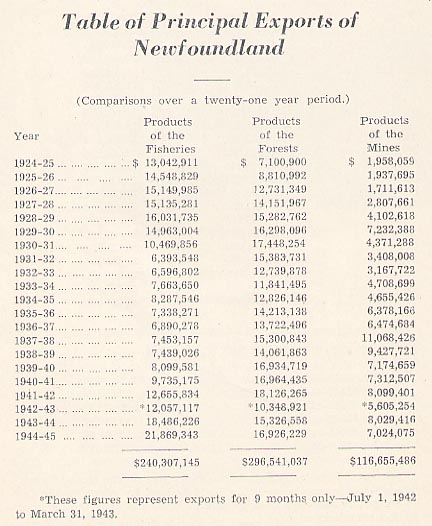
Imports during the same period were from Canada, United
States, United Kingdom, and other countries in this ratio 55 to 40.5 to 6
to 3.5 and consisted of the following commodities:
foodstuffs and beverages... 31.6 per cent
animal and vegetable products . . . 6.0
textiles and clothing . .. . 11.3
wood and paper .. . . . . . . 5.0
non-metallic minerals . .. 12.8
metals and manufactures 7.1
machinery and vehicles .. 17.6
chemicals and allied products 3.5
other products
5.1
Foodstuffs and beverages, the largest class of imports,
amounting altogether to $33,199,000, may be tabulated thus:
flour, meal, grains . . . . . . . .19.3 per cent
vegetables ... 4.8
fruit and juices . . . . . . . . 6.3
fresh meats... 7.3
preserved meats . . . . . . . . 18.6 per cent
sugar and products .. . . . . .13.3
milk and products. . . 7.0
oils and fats, edible .. . . . . . 6.3
tea, coffee, cocoa . . . . . . . .6.3
wines, liquor, beer .. . . . . . 4.5
other..
.. .... . .
6.3
Canada has been the largest supplier of Newfoundland's
imports but has absorbed relatively few of the exports, since most of Newfoundland's
exports have been competitive with Canadian products. Ordinarily Newfoundland
has had a small favourable trading balance with the United Kingdom, and a
strongly favourable balance with her principal fish markets: Puerto Rico,
Portugal, Italy, Jamaica, and Brazil. Since the development of the pulp-and-paper
industry, the highly adverse balance with the United States has been reduced.
Whaling,an industry which lapsed in Newfoundland during the 1920's, shows signs of being revived. In 1946 there were two whaling plants in operation, one in Hawke's harbour, Labrador, and one at Williamsport, White bay. There were 529 whales taken during the year, and the total export value of the products was $950,000 or triple that of the previous year's catch.
© 2004 Claude Bélanger, Marianopolis College |